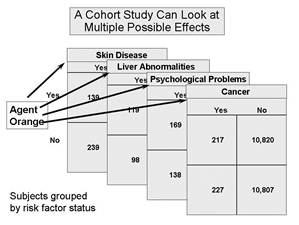Advantages & Disadvantages of Cohort Studies
Advantages
Clarity of Temporal Sequence (Did the exposure precede the outcome?): Cohort studies more clearly indicate the temporal sequence between exposure and outcome, because in a cohort study, subjects are known to be disease-free at the beginning of the observation period when their exposure status is established. In case-control studies, one begins with diseased and non-diseased people and then acertains their prior exposures. This is a reasonable approach to establishing past exposures, but subjects may have difficulty remembering past exposures, and their recollection may be biased by having the outcome (recall bias).
Allow Calculation of Incidence: Cohort studies allow you to calculate the incidence of disease in exposure groups, so you can calculate:
- Absolute risk (incidence)
- Relative risk (risk ratio or rate ratio)
- Risk difference
- Attributable proportion (attributable risk %)
Facilitate Study of Rare Exposures: While a cohort design can be used to investigate common exposures (e.g., risk factors for cardiovascular disease and cancer in the Nurses' Health Study), they are particularly useful for evaluating the effects of rare or unusual exposures, because the investigators can make it a point to identify an adequate number of subjects who have an unusual exposure, e.g.,
- Exposure to toxic chemicals (Agent Orange)
- Adverse effects of drugs (e.g., thalidomide) or treatments (e.g., radiation treatments for ankylosing spondylitis)
- Unusual occupational exposures (e.g., asbestos, or solvents in tire manufacturing, )
Allow Examination of Multiple Effects of a Single Exposure

Avoid Selection Bias at Enrollment: Cohort studies, especially prospective cohort studies, reduce the possibility that the results will be biased by selecting subjects for the comparison group who may be more or less likely to have the outcome of interest, because in a cohort study the outcome is not known at baseline when exposure status is established. Nevertheless, selection bias can occur in retrospective cohort studies (since the outcomes have already occurred at the time of selection), and it can occur in prospective cohort studies as a result of differential loss to follow up.
The "Air Force Health Study" on agent orange illustrates these advantages.
- It was clear that the exposure preceded adverse outcomes among exposed subjects who developed problems.
- It was used to evaluate the effects of an unusual risk factors (agent orange).
- It allowed direct calculation of incidence rates.
- It enabled the investigators to study multiple outcomes of this single unusual exposure.
- The prospective component of the study was not biased by knowledge of outcome status, because the outcomes hadn't occurred at the time of enrollment.
Link to a video on Agent Orange from the the New York Times

Pitfalls:
Disadvantages of Prospective Cohort Studies
- You may have to follow large numbers of subjects for a long time.
- They can be very expensive and time consuming.
- They are not good for rare diseases.
- They are not good for diseases with a long latency.
- Differential loss to follow up can introduce bias.
Disadvantages of Retrospective Cohort Studies
- As with prospective cohort studies, they are not good for very rare diseases.
- If one uses records that were not designed for the study, the available data may be of poor quality.
- There is frequently an absence of data on potential confounding factors if the data was recorded in the past.
- It may be difficult to identify an appropriate exposed cohort and an appropriate comparison group.
- Differential losses to follow up can also bias retrospective cohort studies.


